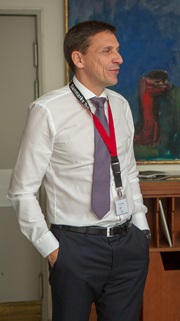For a week in September 2018, Denmark was the center of international efforts to raise oil and gas production rates.
15 countries take part in the Enhanced Oil Recovery (EOR) efforts under the International Energy Agency (IEA). They meet annually to exchange experiences. In 2018, Denmark hosts the conference at a time with EOR being more relevant than ever. Despite renewable energy transition efforts in several countries, the world will remain dependent on oil and gas for the next decades.
 “New large fields are rarely found, while substantial risks are involved around fields at ultradeep waters or in the Arctic region. Therefore, interest in being able to produce more from the existing fields has become very high,” explains Torsten Clemens, Chairman of the EOR Executive Committee under IEA.
“New large fields are rarely found, while substantial risks are involved around fields at ultradeep waters or in the Arctic region. Therefore, interest in being able to produce more from the existing fields has become very high,” explains Torsten Clemens, Chairman of the EOR Executive Committee under IEA.
Torsten Clemens is Chief Scientist for Reservoir Engineering at Austrian based energy corporation OMV, a long-standing member of the CERE industry Consortium.
“Admittedly, the status of Denmark as an oil exporting country surprised me, when I joined the work in IEA,” says Torsten Clemens. “Since, I have learned of the efforts carried out especially by Maersk Oil – now acquired by Total. The carbonate reservoirs in the North Sea are really tight, and being able to produce them is truly impressive. Still, there seems to be a potential for producing even more with improved technology.”
Rising interest in polymer EOR
The annual conferences in the IEA context are a bit different from other conferences on EOR:
“In a traditional format, the presenters will be chosen by a committee based on abstracts. This often leads to some bias, as the committee will tend to favor groups from institutions and countries with a long track record of academic contributions. But in the IEA setup, the member countries choose who to send. This often lead to fresh new input – for instance from Mexico and Colombia. Both countries have joined the cooperation recently,” notes Torsten Clemens.
Another example is China.
“Not least in polymer EOR, China has been the leading country for many years now. Yet, Chinese presentations are quite rare at international conferences, but they always present here,” says Torsten Clemens while adding that polymer EOR has been taken up by a number of other nations besides China – for instance Oman, India, and Canada: “Interest in polymer EOR is growing quite rapidly, while we see a steady situation for most other EOR techniques.“
Historically, steam injection was the first EOR technique to really catch on.
“In fact, you cannot produce a number of heavy oils without steam injection. Especially in the US, steam injection was believed to become very significant, but the successful results for production in shale have decreased the general demand for EOR in USA. Also, other EOR techniques like injection of nitrogen gas are at a relatively stable level.”
Informal discussions are important
Another gas has gained special attention, namely CO2. This is due to the fact, that CO2 injection may not just be an EOR technique but also contribute to climate protection if the CO2 stays underground.
“In principle, this is a very interesting technique. However, some issues around public acceptance remain unsolved. And first and foremost, the costs of separating CO2 from flu gas at power plants are currently too high for the technique to be fully viable.”
Participation in the EOR cooperation in IEA is almost cost-free. No secretariat is maintained, and no joint research schemes are funded. The main activity is exchange of experience. The annual conferences allow the countries to obtain access to results from research activities and field trials which have often been highly costly and surrounded by some secrecy.
“Personal relations are important. Presenters at a conference will traditionally want to convey a nice image. But as a participant, learning of the hardships and obstacles in the various field trials and other projects is also very valuable. This is the type of information, you may be able to get through informal discussions. This is helped by a high level of continuity in the representatives chosen by the 15 countries,” Torsten Clemens concludes.